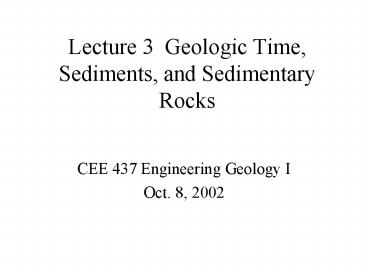Lecture 3 Geologic Time, Sediments, and Sedimentary Rocks - PowerPoint PPT Presentation
1 / 37
Title:
Lecture 3 Geologic Time, Sediments, and Sedimentary Rocks
Description:
Properties depend strongly on post-depositional pore chemistry. Cementation. Dissolution ... Properties can be strong anisotropic and heterogeneous based on bedding ... – PowerPoint PPT presentation
Number of Views:256
Avg rating:3.0/5.0
Title: Lecture 3 Geologic Time, Sediments, and Sedimentary Rocks
1
Lecture 3 Geologic Time, Sediments, and
Sedimentary Rocks
- CEE 437 Engineering Geology I
- Oct. 8, 2002
2
Sedimentary Rocks and Geologic Time
- Geologic Time Scale and it Origins
- Sedimentary Rock Types Depositional Environments
- Engineering Properties
3
Relative Time
- Principle of Superposition
- Fossil Evidence
- Cross Cutting Relationships
- Unconformities
- Alteration
- Fracture Termination
4
(No Transcript)
5
Geologic Time Scale Eras
- Precambrian Minimal fossil record
- Era, Period, Epoch
- Based on major changes extinctions, mountain
building events
6
Paleozoic (Old Life) Brachiopods, Trilobites,
Fish
- Periods based on English Geology
- Cambrian for Latin Wales
- Ordovician and Silurian for ancient Welsh Tribes
- Devonian for Devon
- Carboniferous for Coal Measures (also
Mississippian and Pennsylvanian in US) - Permian for Perm Basin in Ukraine
7
Mesozoic (Middle Life) Ammonites, Dinosaurs
- Triassic based on distinctive three-layer
stratigraphy in southern Germany - Jurassic based on Jura Mountains in France and
Switzerland - Cretaceous (Latin for Chalk) based on chalk unit
that forms Dovers cliffs
8
Cenozoic (Recent Life) Mammals, Modern marine
fauna (foraminifera)
- Periods are Tertiary (before Ice Ages) and
Quaternary (ice ages) - Primary and secondary have been long replaces
- Rocks of western Washington are primarily
Tertiary and Quaternary in age
9
Age of the Earth
- Kelvin and a basis in heat flow (set at 20
million years) - Problem of fitting all of evolution in this time
- Rutherford and the introduction radioactive decay
- Added a head source, pushed ages back to 4.5
billion years
10
Absolute Time
- Basis on radiometric dating Common dating tools
- 14C, K-Ar, Rb-Sr,Uranium decay series
11
Sedimentary Rocks
- Clastics, Siliciclastics, Carbonates, and
Evaporites - Clastic rocks, depositional medium, and energy
- Diagenesis chemical changes after deposition
12
Clastic Sedimentary Rocks
- Clastic broken like iconoclast)
- Often referred to as Siliciclastics as having Si
based rock forming minerals - Based on grain size and to a lesser extent
composition - Grain size related to energy of depositional
environment - Relationship of medium velocity to maximum grain
size)
13
Clastic Sedimentary Rocks
- Clay, muds ? shales, mudstones, claystones
(difference based on fissility) - Silts ? siltstones
- Sands ? sandstones
- Gravels ? Conglomerates (Breccia if angular,
breccia may also be a term for tectonically
fragmented rock)
14
Weathering Cycle
15
Clastic Sediments
16
(No Transcript)
17
Classification of Sedimentary Rocks (ex.
evaporites and coal)
18
Clay Minerals
- Sheets of linked silica tetrahedra sandwiching
octahedral layers of gibbsite composition,
Al2(OH)6, or brucite Mg3(OH)6 - Major Clay Groups
- kaolinite single gibbsite layer
- montmorilloniteweak water bonding between
layers, moderated by Ca, Na, or K (near-shore
environments) - illite K bonds between layers (off-shore
environments) - bentonite highly expansive, volcanic-derived,
Na-rich montmorillonite
19
Clay Structure
20
Clay Structure Contd.
Kaolinite
Montmorillonite
Illite
21
Clay Plasticity
22
Lithification
- Cementation
- deposition of a material different from clasts
- Crystallization
- crystal growth on clasts to fill pore space
- Compaction
- Diagenesis
- Early post-depositional chemical transformation
of sediments, e.g. calcite to dolomite
23
Carbonates
- Generally like siliciclastics carbonate muds,
sands, etc. - Often deposited in reefs
- Major portion of world oil deposits
- Properties depend strongly on post-depositional
pore chemistry - Cementation
- Dissolution
24
Carbonate Environments
25
Evaporites
- Rock salt (NaCl), Gypsum-Anhydrite (CaSO4),
Sylvite (KCl) - Deposition in regions where evaporation exceeds
recharge - desert lakes
- restricted seas (Mediterranean)
- lagoons, back-reef areas
- Subject to flow and diapirism
26
Other Sedimentary Rocks
- Chert finely crystalline silica
- as replacement/diagenetic nodules
- as bedded material from silica-shelled biota
- Coal
- Derived from vegetation
- Banded Iron Formation
- Likely bacteria derived, mainly Pre-Cambrian
27
Sedimentary Rocks and Rock Properties
- Properties for a given geologic description vary
wildly based on cementation, porosity and other
diagenetic factors. - Properties can be strong anisotropic and
heterogeneous based on bedding
28
Expanding Sedimentary Materials
- Expanding clays (especially bentonite)
- Gypsum-Anhydrite hydration (CaSO4)
29
Depositional Environments
- Synchronicity of deposition of different rock
types - Sedimentary facies
- A rock unit is not everywhere the same age
Bright Angel Shale - Related to energy of environment
- (example channels and banks in fluvial systems)
- Energy related to topography, climate, and
tectonic activity
30
Sediment Sorting
31
Sedimentary Structures Load Casts, Rip-ups, etc.
32
Sedimentary Structure Cross Bedding
33
Fluvial and Lacustrine Environments
- Fluvial
- Channelization
- Complex and close interrelationship of fine and
course sediments - Challenge for characterization due to high
variability - Special examples glacial environments
- Lacustrine
- Deltaic deposits at margins, finer materials in
lake beds
34
Deltaic Environments
- Variability based on proximity to source
- Stratigraphy effected by progradation
35
Deltaic Development and Sedimentary Facies
36
Continental Slope Environments
- Turbidites and turbidity currents
- Graded bedding
- poor sorting
- vertical zonation with fining upwards
37
Turbidites and Turbidity Currents
- Formed by mobilization of sediments on slopes
- Graded bedding (coarse at bottom, fining upwards)































